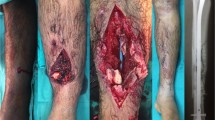Abstract
Most gunshot injuries to the hand involve a combination of tissue types. The goal of this study is to report the results of early definitive treatment in extra-articular metacarpal and proximal phalangeal fractures due to low velocity gunshot wounds and to analyse their outcomes. A retrospective analysis of 51 metacarpal and 41 proximal phalangeal fractures of 76 patients due to low velocity gunshot wounds treated between January 2001 and December 2004 was carried out. We applied acute fixation in the first 24 hours. The patients were evaluated with total active motion scores, radiographic control, complication rate and the need for revision surgery. The infection frequency was 10.5% and the need for a revision surgery was 7%. The plate fixation group had significantly higher total active motion scores than the external fixation group. The K wire group had the highest revision rate. The bone grafting group was associated with good total active motion scores and low complication rates. The majority of the low velocity gunshot injuries are surgically clean wounds which allow not only early fracture fixation, but also early bone grafting and soft tissue reconstruction. Plate and screw fixation is associated with significantly better functional outcomes than the minimal fixation group.
Résumé
Les blessures par armes à feu au niveau de la main entraînent des lésions tissulaires complexes. Le but de cette étude est de rapporter les résultats du traitement des fractures des phalanges proximales et des métacarpiens en fonction de la force du tir. Une analyse rétrospective de 51 fractures métacarpiennes et de 41 fractures des phalanges proximales sur 76 patients ont été traitées entre janvier 2001 et décembre 2004. Nous avons réalisé une fixation de première intention en urgence dans les 24 premières heures. Ces patients ont été évalués par la mobilité, l’aspect radiographique et le taux de complication. Le taux d’infection a été de 10,5% et les nécessités de reprises chirurgicales de 7%. Le groupe des patients traités par plaque a une mobilité plus importante que ceux traités par fixateurs externes. Le groupe des patients brochés a entraîné un taux important de réinterventions. Le groupe des patients greffés a bénéficié d’une bonne récupération de la mobilité et d’un taux de complication relativement bas. La majorité des blessures par armes à feu avec une vitesse de pénétration relativement lente permet à la plaie d’être relativement propre et permet également une fixation de la fracture et une greffe précoce ainsi qu’une reconstruction des tissus mous. Une ostéosynthèse par plaque et vis peut être associée avec un résultat fonctionnel bien meilleur que ceux bénéficiant d’une fixation plus aléatoire.





Similar content being viewed by others
References
Bartlett CS (2003) Clinical update: gunshot wound ballistics. Clin Orthop (408):28–57
Chappell JE, Mitra A, Weinberger J et al (1999) Gunshot wounds to the hand: Management and economic impact. Ann Plast Surg 42(4):418–423
Dugas R, D’Ambrosia R (1985) Civilian gunshots to the hand. Orthopedics 8:1121–1125
Freeland AE, Jabaley ME, Burkhalter WE, et al (1984) Delayed primary bone grafting in the hand and wrist after traumatic bone loss. J Hand Surg Am 9A:22–28
Green David P, Hotchkiss Robert N, Pederson William C et al (2005) Green’s Operative Hand Surgery. Churchill Livingstone, Philadelphia, Pennsylvania
Gonzalez MH, McKay W, Hall RF Jr. (1993) Treatment by early stable fixation and bone grafting. J Hand Surg Am 18(2):267–270
Gonzalez MH, Hall M, Hall RF Jr (1998) Low-velocity Gunshot Wounds of the proximal phalanx: treatment by early stable fixation. J Hand Surg Am 23(1):150–155
Kiehn MW, Mitra A, Gutowski KA (2005) Fracture management of civilian gunshot wounds to the hand. Plast Reconstr Surg 115(2):478–481
Punn WK, Chow SP, So YC (1991) Unstable phalangeal fractures: treatment by AO screw and plate fixation. J Hand Surg Am 16A:113–117
Saint-Cyr M, Miranda D, Gonzalez R et al (2006) Immediate corticocancellous bone autografting in segmental bone defects of the hand. J Hand Surg Br 31(2):168–177
Seitz WH Jr, Gomez W, Putnam MD et al (1987) Management of severe hand trauma with a mini external fixateur. Orthopedic 10(4):601
Wilson RH (2003) Gunshots to the hand and upper extremity. Clin Ort 408:133–144
Author information
Authors and Affiliations
Corresponding author
Rights and permissions
About this article
Cite this article
Kömürcü, M., Alemdaroğlu, B., Kürklü, M. et al. Handgun injuries with metacarpal and proximal phalangeal fractures: early definitive treatment. International Orthopaedics (SICO 32, 257–262 (2008). https://doi.org/10.1007/s00264-006-0312-7
Received:
Revised:
Accepted:
Published:
Issue Date:
DOI: https://doi.org/10.1007/s00264-006-0312-7




